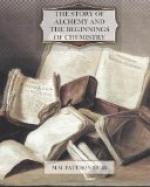We are accustomed to-day to use the words fire and water with different meanings, according to the ideas we wish to express. When we say “do not touch the fire,” or “put your hand into the water,” we are regarding fire and water as material things; when we say “the house is on fire,” or speak of “a diamond of the first water,” we are thinking of the condition or state of a burning body, or of a substance as transparent as water. When we say “put out the fire,” or “his heart became as water,” we are referring to the act of burning, or are using an image which likens the thing spoken of to a substance in the act of liquefying.
As we do to-day, so the alchemists did before us; they used the words fire and water to express different ideas.
Such terms as hardness, softness, coldness, toughness, and the like, are employed for the purpose of bringing together into one point of view different things which are alike in, at least, one respect. Hard things may differ in size, weight, shape, colour, texture, &c. A soft thing may weigh the same as a hard thing; both may have the same colour or the same size, or be at the same temperature, and so on. By classing together various things as hard or soft, or smooth or rough, we eliminate (for the time) all the properties wherein the things differ, and regard them only as having one property in common. The words hardness, softness, &c., are useful class-marks.
Similarly the alchemical Elements and Principles were useful class-marks.
We must not suppose that when the alchemists spoke of certain things as formed from, or by the union of, the same Elements or the same Principles, they meant that these things contained a common substance. Their Elements and Principles were not thought of as substances, at least not in the modern meaning of the expression, a substance; they were qualities only.
If we think of the alchemical elements earth, air, fire, and water, as general expressions of what seemed to the alchemists the most important properties of all substances, we may be able to attach some kind of meaning to the sayings of Basil Valentine, which I have quoted. For instance, when that alchemist tells us, “Fire is the most passive of all elements, and resembles a chariot; when it is drawn, it moves; when it is not drawn, it stands still”—we may suppose he meant to express the fact that a vast number of substances can be burnt, and that combustion does not begin of itself, but requires an external agency to start it.
Unfortunately, most of the terms which the alchemists used to designate their Elements and Principles are terms which are now employed to designate specific substances. The word fire is still employed rather as a quality of many things under special conditions, than as a specific substance; but earth, water, air, salt, sulphur, and mercury, are to-day the names applied to certain groups of properties, each of which is different from all other groups of properties, and is, therefore, called, in ordinary speech, a definite kind of matter.




